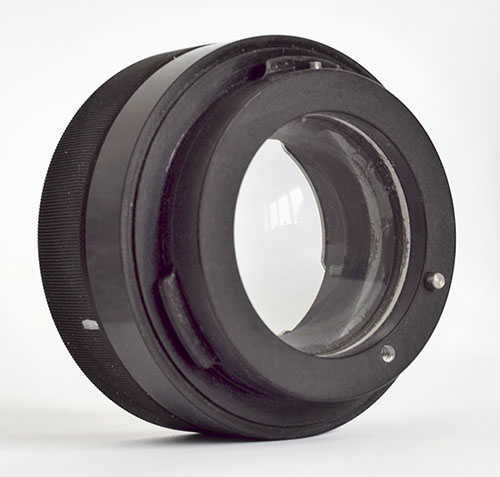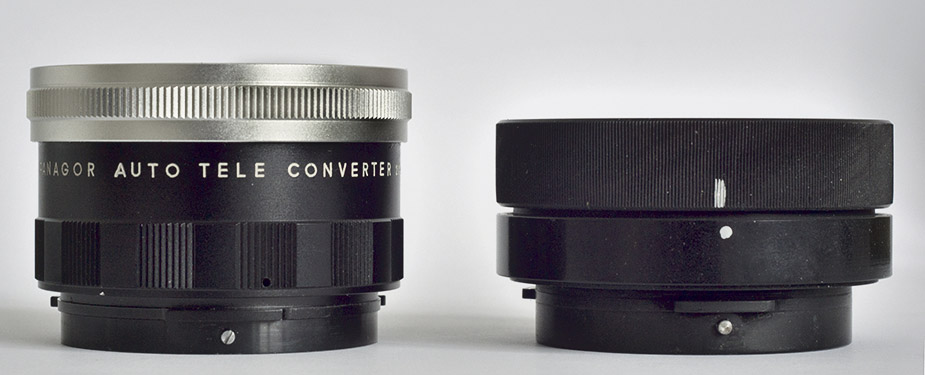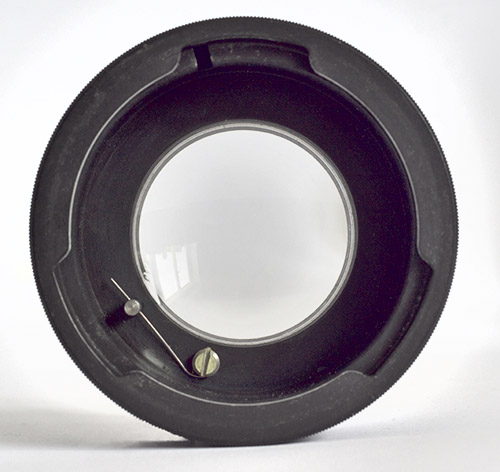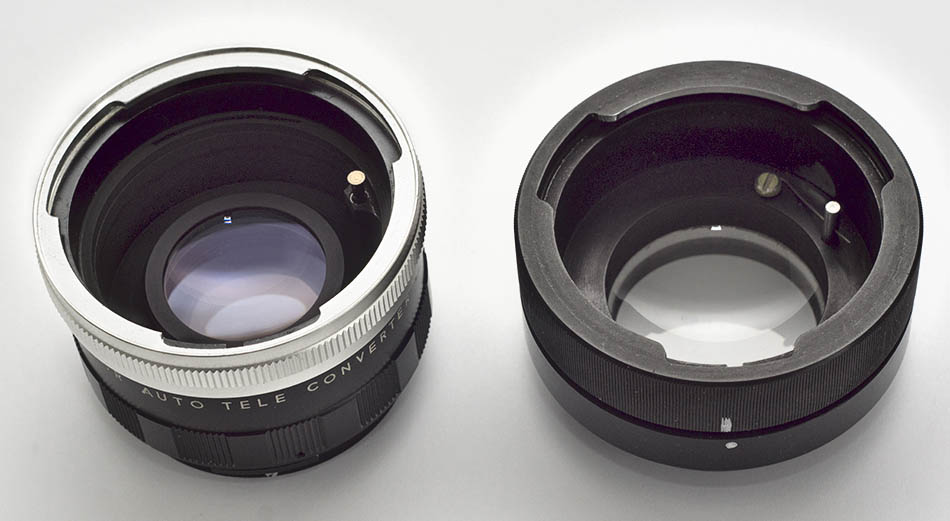
A "mystery converter" for the Pentacon Six
[myscon01.jpg]
| This particular converter has no
manufacturer's name nor any other engraving or
printing on it. Tests on a Pentacon Six show
that there is a light loss equivalent to two stops
when it is mounted between the 80mm Biometar and the
camera body. This is the amount of light loss
that would normally correspond to a 2× converter,
although by my initial calculation this converter
appears to magnify by a little less than 2×. The fit of the back of the converter onto the Pentacon Six is fine, but fitting a Pentacon Six lens onto the front of the converter is difficult -- and getting the lens off the converter again is even harder! It would appear that some further machining will be required, or some grinding or filing, to improve the fit. |
 The "mystery converter" shown
beside the Panagor Auto Tele Plus,
to enable the relative sizes to be compared. [myscon03.jpg] |
There is no locking screw to prevent
winding the bayonet locking ring completely off the
converter. (This is about six full turns, so it
won't come off accidentally.) More important,
the lack of a locking screw (and a hidden groove for
it to run in) prevents the locking ring from being
left wound too far in before trying to attach the
lens. An index mark and a line on the locking ring are therefore necessary to show the required position of the ring for removing the lens. A mark and a line have been added manually (and not very professionally), perhaps by a previous owner. This converter is 30mm deep from lens flange to camera flange. The lens element or elements is/are deeply concave on the front surface and slightly convex on the rear surface. In this particular converter they appear to have been glued (!) into position (see picture at top of this page), a procedure that makes subsequent servicing virtually impossible. |
| The converter has an auto-aperture
pin to maintain the auto-aperture operation of the
lens diaphragm, although the spring by which it is
held in place is too weak to hold the pin fully in the
"back" position, instead pushing it about half way
back. The pin, however, adequately fulfils its
function: it enables the camera to open the lens
diaphragm fully when the shutter is cocked and
allows the diaphragm to close down when the
shutter is fired. As suggested below, perhaps
this "spring" is merely a piece of wire that has been
used to prevent the pin falling out. The converter came with no instructions and without front and rear caps. Of course, users sometimes lose instructions and caps, so this converter might originally have been supplied with both. The auto-aperture pin and the wire that holds it in place |
 [myscon02.jpg]
|
 This view of the "mystery converter", compared with the Panagor, would appear to indicate that the element(s) in it is/are not coated. [myscon04.jpg] |
Infinity focus With the "mystery converter", infinity focus is maintained -- virtually. By this I mean "not quite"! However, I believe this slight lack would not be visible in normal use. In the viewfinder of my Pentacon Six I can only see a tiny mis-alignment of the two parts of a vertical line of an object that is at a great distance, with the lens focussed on infinity, thanks to the fact that I have a Rollei MKPG focussing screen in the camera, and this has excellent rangefinder wedges in the centre of the screen. With most focussing screens, this would not be visible in the viewfinder. More important, it is not likely to be visible in images! |
| Some comments from a German expert A German expert in all aspects of the Pentacon Six wrote to me: “In my opinion (I have no proof), this is something that was manufactured "in quantity" on a kitchen table. In the fifties and beyond it was not difficult to make a converter yourself. Several companies (CZJ among them) offered lens element kits along with data and instructions for these. i.e., you bought the lens kit, and the pamphlet from Zeiss told you the distance from the film plane in which to mount it. From there on, you were on your own. They also had lenses for making macro attachments. “... So I believe the lens elements have been bought from one of the many manufacturing companies. I guess the mechanical parts were made on the side wherever the person making them worked. “I have seen about half a dozen. Most of these somehow differ slightly from one another. I believe whoever made them bought a couple of lens elements, made some lens bodies, and sold them before buying new elements. The varieties could be explained by small batches with lots of time in between. “The converters are shoddily made. They have been simply painted black instead of anodized. Most of the converters display some flaw, like an extra hole in the base of the lens mount or a breech mount with a too-wide tooth. The single lens element is held by a Klemmring [a circlip], a circle of steel with a cutout so that you can squeeze it slightly, insert it into the tube and then release it again. The spring to push the aperture pin is just a simple wire.” |
Test results
I naturally hope to be able to test this converter in the "real world". However, I will first need to grind down or file down part of the mount on the front end of the converter. I don't want to risk damaging my lenses while trying to mount or remove them!
To return to the main page on teleconverters, click here.
To go on to the next section on lens data (Other lenses in the Pentacon Six mount), click here.